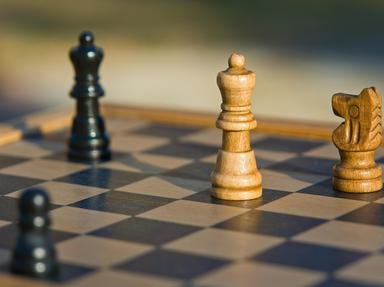Quiz Answer Key and Fun Facts
1. After the moves, 1.f3 e5 2.g4 ... How does Black end the game with checkmate?
2. After the moves, 1.e4 e5 2.Bc4 Nc6 3.Qh5 Nf6, White may deliver mate. Which move should White play?
3. 1.d4 Nf6
2.Nd2 e5
Generally, knights should be played to c3 and f3. As you will see, the knight on d2 poses problems for White. The game continues, 3.dxe5 Ng4 4.h3. What is the winning move for Black?
4. The following moves come from a correspondence game played in 1930: 1.d4 Nf6 2.c4 e5 3.dxe5 Ne4 4.a3 d6 5.exd6 Bxd6 6.g3 ... This a bit tricky, but which move wins material?
5. This game was played in Berlin in 1950. The game began: 1.e4 e6 2.d4 d5 3.Nd2 c5 4.exd5 exd5 5.dxc5 Bxc5 6.Ne2 ... A seemingly simple queen move wins the game. Which move is it?
6. This is another good example of poor Knight deployment. Black arrives at a Pirc/Modern Defense by transposition but plays too passively. The position in the diagram is reached after these moves: 1.e4 d6 2.d4 Nd7 3.Bc4 g6 4.Nf3 Bg7 5.Bxf7+ Kxf7 6.Ng5+ Kf6. Which move concludes the game with checkmate?
7. This game demonstrates the famous, "Legal's Mate." The opening moves are: 1.e4 e5 2.Nf3 d6. Black plays 2. ... d6, the Philidor Defense. It is a solid opening although considered to be somewhat passive. The game continues: 3.Bc4 Bg4 4.Nc3 g6 5.Nxe5 Bxd1 6.Bxf7+ Ke7. Which move delivers checkmate?
8. New Orleans, Louisiana was a veritable hotbed of chess activity in the 19th century. Here is an example of brilliant chess played by one of the chess masters active during that era.
1.e4 e5 2.f4 exf4 3.Nf3 d5 4.Nc3 dxe4 5.Nxe4 Bg4 6.Qe2 Bxf3.
White's queen is being attacked. However White brilliantly ends the game with which of the following moves?
9. Even though Black violates a basic principle of opening play by moving the same piece twice without having developed other pieces, it works out for Black in the end. The opening is the Vienna Game. 1.e4 e5 2.Nf3 Nc6 3.Bc4 Nd4 4.Nxe5 Qg5 5.Nxf7 Qxg2 6.Rf1 Qxe4+ 7.Be2 ... How does Black end the game?
10. In this game, the technique of under-promotion is demonstrated. Here are the moves: 1.e4 e5 2.f4 exf4 3.b3 Qh4+ 4.g3 fxg3 5.h3 g2+ 6.Ke2 Qxe4+ 7.Kf2 gxh1. After 7. ...gxh1, Black may promote the pawn to another piece. Which piece is the best choice in order to immediately end the game?
Source: Author
christopherm
This quiz was reviewed by FunTrivia editor
WesleyCrusher before going online.
Any errors found in FunTrivia content are routinely corrected through our feedback system.

